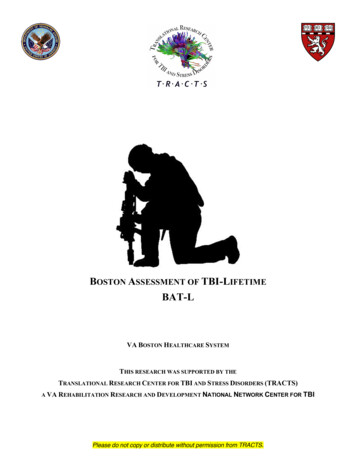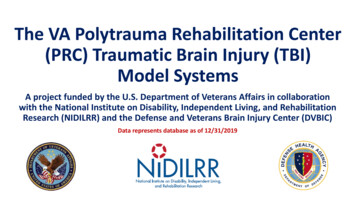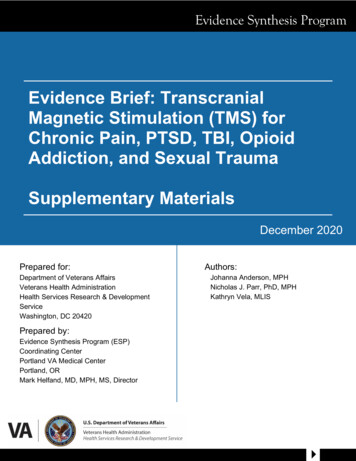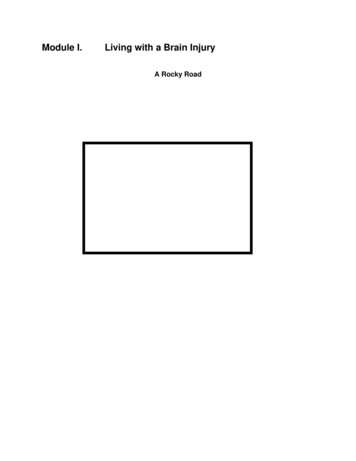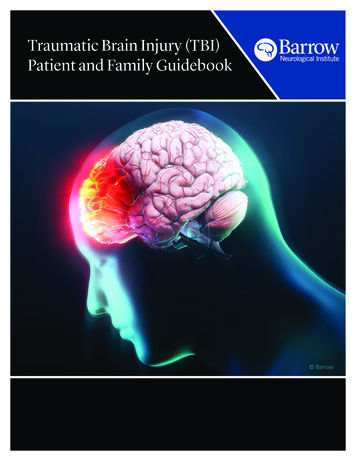
Transcription
Traumatic Brain Injury (TBI)Patient and Family Guidebook Barrow
I am GINA your Guidebook Information Navigating AssistantThroughout this guidebook, I will provide information and education about traumatic brain injurycare and treatment. I know that I will not have answers to all of your questions, but our incrediblehealthcare team is available to you and your family to answer all questions in real-time.We are here for you.Please keep the guidebook in your hospital room so that your healthcare team may add materialspecific to you. This guidebook is intended to be an introductory resource and to serve as part ofyour comprehensive rehabilitation program.Please let us know if we can assist you in any way.
Traumatic Brain Injury (TBI)Patient and Family GuidebookTable of ContentsMeet Your Team.2What Happens After TBI?.3What is My Injury?.4What Area of My Brain is Hurt?.6How Severe is My Brain Injury?.7What Tests Are Done?.8In the Hospital, What Happens to Me?.9Milestone 1 - Care, Treatment, and Brain Monitoring: What Happens to Me?.10What Treatments are Used in the ICU?.11Brain Monitoring and Treatment.12Milestone 2 - Airway and Breathing.13Milestone 3 - Heart, Blood Pressure, Movement, and Pain Management.14Milestone 4 - Thinking and Consciousness.15Milestone 5 - Eating, Nutrition, and Toileting.17Urinating and Bowel Movements.18From the Hospital, What Happens Next?.19How Do I Monitor My Symptoms at Home?.20What Can I Do to Stay Safe at Home?.21Who Can I Call for Help After Leaving the Hospital?.23My Tests, My Team, and My Progress (Fill in).26Notes.28References.301
Meet Your TeamSurgeonsNeurosurgeon - trained in care for brain disorders including TBITrauma/General surgeon - trained in care for traumatic injury of body and TBIOrthopedic surgeon - trained in care for broken bonesCritical Care and InternalMedicine ProvidersChaplainHelps with emotional &spiritual support, and withadvanced directivesDoctors and Advance PracticeProviders who help managemedications and treatmentRespiratory TherapistResidentHelps treat breathing andoxygenationCare Coordinator/Social WorkerHelps with insurance anddischarge needs includingfinding a rehabilitation facilityand arranging for home needsDoctor in training who workswith surgeons to providesurgical and medical carePatient &FamilyAdvanced practice providerswho work with doctors toprovide medical and surgicalcare to TBI patientsPharmacistHelps manage all medicationsin the hospitalNurseWorks with the patient,family and providers to helpmanage the TBI and anyother conditionsRegistered DietitianHelps with making your dietand food for you to healNurse Practitioner/Physician AssistantsTherapistPhysical Therapist - helps improve strength and balanceOccupational Therapist - helps develop ways to take care of yourselfSpeech Therapist - helps with thinking and swallowing2
What Happens After TBI?Normal BrainThe nerve cells or information connections in the brain send message to our body to control movement,sensations such as seeing, hearing, touching, feeling, and speaking along with our breathing, heartbeat,digestion, bowel, and bladder.How Does Traumatic Brain Injury (TBI) Affect My Body?TBI can change your normal brain function. Damage to the brain cells due to bleeding, tearing, brainswelling, or a broken skull can change the brain’s ability to send messages to the body. The brain also cannotunderstand messages sent from the body. For example, the brain may not recognize if you are in pain.TBIBrain Cells3
What is My Injury?8614736524
What is My Injury?16Skull fractureIntracerebral Hemorrhage and/or Brain Contusion (bruise) Skull bone is broken Can be small break and brainstays in the skull Can be larger break and braincomes out of skull2 Blood clot or bruises in thebrain - can be in multipleplaces Can increase in size over dayslike bruises on the arms or legs May need other brainmonitoring May need surgery to treatDiffuse Axonal Injury (DAI) Can be mild or severe braininjury Damage to the nerveconnections that send messagesto the body378Herniation (Purple arrows) Pressure from an injury movesthe brain from its normalspace in the skull Can cause other parts of thebrain to be injured May need surgery to removethe pressure on the brainSubdural Hematoma Bleeding outside of brain(between the skull and the brain) Can happen at time of injury orforms slowly over weeks May need surgery to treat ifpressing down on brain May need other brain monitoring5 Blood clot in the spaces of thebrain May need other brainmonitoring or drain to preventelevated pressure within theskull May need surgery to treat.Epidural Hematoma Bleeding outside of brain(between the skull and the brain) May need surgery to remove ifpressing down on brain May need other brain monitoring4Intraventricular HemorrhageSubarachnoid Hemorrhage Bleeding outside of brain(between the skull and the brain) Injury that is not due to rupturedaneurysm May need other brain monitoring59Concussion No changes are seen onimaging. Symptom management
What Area of My Brain is Hurt?Symptoms from a TBI depend on the severity of injury and the location of the injury in the brain.Some areas of the brain are extremely small but necessary for life. Injury to these critical areas cansometimes lead to death.5 Issues That Can Happen After a TBI1. Difficulty with thinking, memory, learning, making decisions and reasoning.2. Behavior and emotion problems. You may be confused, agitated, sad, depressed,anxious or angry. You may yell out or try to hit others.3. Strength and balance problems, as well as problems with walking or coordination.4. You may have changes in your vision, hearing, taste, and be sensitive to light.5. Headaches and pain, dizziness, nausea and vomiting, fatigue and tiredness, andsleeping problems.CDC Chart to Congress6
How Severe Is My Injury?TBI can sometimes get worse before it gets better. Damage to the brain happens at the time of injury andcan also continue in the following days to weeks due to swelling or bleeding in and around the brain. 2000 Barrow Barrow 2003 BarrowMild TBIModerate TBISevere TBI May or may not loseconsciousness. May lose consciousness Most amount of brain injury May not be aware ofsurroundings Not awake-comatose Aware of your environmentbut may be confused May need care in hospital Testing may show brainand skull as normal May have problems withstrength, speech, andthinking May not be awake Will need care in hospital May need care in theintensive care unit Testing will show injury tobrain or skull7 May have problems withstrength, speech, andthinking Will need care in theintensive care unit Testing will show injury tobrain or skull
What Tests Are Done?Magnetic Resonance Imaging (MRI) andComputerized Tomography (CT)Pictures of your brain using CT or MRI will be done to look for theplace in the brain that is hurt. As you heal you may have morepictures taken to follow how you are healing.Electroencephalogram (EEG)TBI can cause seizures. Sensor pads may be placed on the scalpand facial areas to look for seizures with an electroencephalogram(EEG). If you have seizures, you will be given medications to stopthe seizures.Blood Tests (Laboratory Tests)Your blood will be drawn to measure lab values and providetreatment if needed.MonitoringYour heart rate and heart waveform, oxygenation, blood pressure,respirations, and temperature will be monitored.Physical and Neurological ExaminationDoctors, nurses, and therapists will ask you questions multiple timesduring the day and night to monitor your neurological status. Theywill also ask you follow instructions to test your thinking, strength,and coordination to determine treatment. This is how we make sureyou are healing.8
In the Hospital, What Happens to Me?After coming in through the emergency department, you may be in the ICUor the telemetry (heart monitor) floor. Let’s start with the 5 milestones youcan expect after a TBI.Milestone 1ICU Care, Treatment, and Possible Brain MonitoringThe focus will be on your neurological examination and overall medical stability. You mayneed tubes and other monitors to keep you safe.Milestone 2Airway and BreathingYour team will make sure you have enough oxygen and are breathing ok. You may require abreathing tube and or other tubes to give you oxygen.Milestone 3Heart, Blood Pressure, Movement, and Pain ManagementOnce your vital signs and neurological examination are stable you will be helped out of bed.We will give you pain medications if needed to keep you comfortable.Milestone 4Thinking and ConsciousnessWe continue supporting your recovery as your thinking and awareness of your surroundingsimproves.Milestone 5Eating, Nutrition, and ToiletingWe will make sure you have food to heal and that you are able to urinate and have bowelmovements.9
Milestone 1Care, Treatment, and Brain Monitoring:What Happens to Me?You may have many tubes and devices that help with your care andmonitor your stability.Your doctors, nurses, and respiratory therapists will show you what lines and machinesyou are using and may need in the future.10
What Treatments are Used in the ICU?Your team may use the following to treat pressure (swelling) in the brain:Medical and Nursing Care Monitor neurological exam Medications and IV fluid management Keep vital signs and oxygenation normal Monitor brain with CT scans and/or MRIs Monitor lab values Prevent infection Treat seizuresICP Monitoring Treat ICP above 22 Draining excess fluid on the brain Keeping the head of the bed elevated to drain CSF Keep environment calm Promote restSurgery Remove blood clots within the brain Remove part of the skull so the brain has room to swell11
Brain Monitoring & TreatmentICP monitoring may be done if you have a severe TBI.The neurosurgeon will place an ICP monitor. This can be either a wire with a sensor in thebrain or a drain called an external ventricular drain (EVD) that is placed into the ventricles ofyour brain. ICP monitors help measure the pressure of the brain and drain cerebrospinal fluid (CSF) toprevent high pressure in your brain. Your doctors and nurses will keep your brain pressure below 22 while your brain is healing Monitoring ICP helps assess that the treatment plan is working, or help make changes toyour treatment The monitors will be removed once ICPs are no longer high 2016 Barrow12
Milestone 2Airway and BreathingLung and Heart AnatomyIf you are not breathing well, you may need a breathing tube inserted andconnected to a breathing machine and oxygen (ventilator). The breathing tube and machine will be removed once you can safely breathe on yourown. Some people need more time to be able to safely breathe on their own due to the severityof the brain injury, or they have other lung injury or infections. If you need the breathingtube for longer than a week, it may be removed from your mouth and placed in yourneck. This is called a tracheostomy. Tracheostomies may be removed at a later time once you have recovered.Breathing TubeTracheostomy13
Milestone 3Heart, Blood Pressure, Movement, and Pain ManagementThe brain needs a constant flow of blood to carry the oxygen and nutrientssuch as sugar (glucose) to feed your brain cells.Your heart and blood pressure will be monitored using:1. Heart monitor pads are placed on the chest to measure heart rate.2. Blood pressure cuffs3. If frequent blood pressure monitoring is needed, a sensor is placed in the artery of thewrist and connected to a blood pressure monitor.Your nurses, physical, and occupational therapists will do the following tohelp with blood flow and other complication such a blood clot formation(Deep Vein Thrombosis - DVT): Sit you up in bed Get you out of bed with help; youmay need to be slid from the bed toa specialty chair Move your arms and legs Use specialty compression stockingon your legs called SCDs (sequentialcompression device) Physical and occupational therapywork with you to get stronger,improve your balance, and help youeat, dress, and toilet. Pain medicines and supportivetherapy will be used to help you becomfortable to get up out of bed andwork with your therapists to recoverWhen you are in bed or out of bed, you may need the following for your safety: Restraints may be placed to keep you from pulling tubes Alarms may be placed on chairs to help prevent falls Helmets may be used for protection after surgery and part of the skull is removed14
Milestone 4Thinking and ConsciousnessRanchos is a tool used to help monitor your thinking. Families and friendscan help you during your recovery.Always use a calm tone and voice:Ranchos LevelsWhat can family and friends do to help?Level I: No Response Talk to your family member in normalvoice, tell where they are and whathappened Move arms and legs if ok with the nurse Hold hands Limit the number of visitors to 2-3 peopleat a time. Keep the room calm and quiet. Bring in favorite belongings and pictures Give rest periods Watch TVNo response to stimulationLevel II: Generalized ResponseSome response to stimulationLevel III: Localized ResponseAwake on/off during the day.May recognize family and beginto respond inconsistently tosimple questions with “yes” and“no” head nods.Level IV: Confused/AgitatedMay overreact and hit, scream,or use abusive language. This isdue to confusion, feeling scaredand not understanding what ishappening. May be restrained.Level V: Confused/InappropriateMay only able to pay attention foronly a few minutes. Becomeoverloaded and restless whentired or when there are too manypeople around.15 All of above Keep comments and questions short Use 1 or 2 step directions at a time “canyou turn your head and look at me? Tell them where they are and whathappened Reassure they are safe Allow as much movement as is safe Do not force them to do things Listen to what they wants to do and followhis lead, within safety limits. Give breaks and change activitiesfrequently. Re-orient repeat and remind Don’t assume that he will remember whatyou tell him Keep comments and questions short andsimple Help organize and get started on an activity Give frequent rest periods.
Ranchos LevelsLevel VI: Confused/AppropriateMay know they are hospitalizedbecause of an injury, but will notunderstand all of the problems.What can family and friends do to help? Repeat and discuss things that have happenedduring the day to help improve memory Encourage participation in all therapies.May be more aware of physicalproblems than thinking problemsand think that all will be fine assoon as they go home.Level VII: Automatic/AppropriateMay have problems with attentionand be distracted. May havedifficulty planning, starting, andfollowing through with activities.May not realize how his thinkingand memory problems may affectfuture plans and have rigidthinking.Level VII: Purposeful/AppropriateMay realize that there is a problemin thinking and memory and beginto compensate for problems. Maybegin to be more flexible and lessrigid in their thinking. Talk with them as an adult Be careful when joking or using slang, becausethey may misunderstand the meaning Do not criticize Reassure that the problems are because of the TBI Strongly encourage to continue with therapy Be sure to check with the physician on restrictionsconcerning, driving, working, and other activities Discourage from drinking or using drugs, due tomedical complications Talk about feelings 5 RLOCFOriginalFamilyGuide-English.pdf16
Milestone 5Eating, Nutrition, and ToiletingAfter a TBI, swallowing ability may be impaired.It may be unsafe for you to take food by mouth without risk of choking which puts you atrisk for complications like aspiration of food into lungs and pneumonia. You may be too tired to eat enough food and get enough calories to heal. A speech language pathologist (SLP) will work with you to see if you are safe to swallow,and what kind of food you can have that is safe for you to eat. If you are unable to swallow safely or are too tired to eat, you may have a temporaryfeeding tube placed so liquid nutrition and medications may be given.- These feeding tubes are placed through the nose down into the stomach and smallintestine. These tubes are used only in the hospital. If your swallow does not get better in the hospital, you may need the feeding tube placeddirectly into your stomach. These tubes can be in place for months or be permanent. Thetube can be removed if you are able to eat and swallow safely.TemporaryFeeding TubeStandardFeeding TubeLow-ProfileFeeding TubeRegistered dietitians are experts in nutrition and work with youand your team to determine what food will work best for youeither by mouth or through the feeding tube.17
Urinating and Bowel MovementsUrinatingInitially, you may have a tube in you bladder to drain and measure urine (a catheter). This urinary catheter tube is typically removed after a few days to prevent infection. After this, some people may be unable to empty their bladder of urine need scheduled catheterizationevery 4-6 hours. A bladder training schedule may be implemented that can be continued at home.BowelsLack of physical movement and pain medications can cause constipation. This urinary catheter tube is typically removed after a few days to prevent infection. Your team will give you medications by mouth and rectally to help you have bowel movement Your registered dietitian will help with your diet.18
From the Hospital, What Happens Next?As you become stable and leave the ICU, you may transfer to a regularhospital floor or a telemetry (heart monitored) floor for a few more days ofmonitoring.The place you go after your discharge from the hospital can vary depending on your level ofrecovery and your insurance: Examples include the following: Long-Term Acute Care HospitalWhen a person has stabilized but needs longerhospital care. Acute Rehab FacilityA person stays here and participatestherapies for 3 hours per day. Typically forshorter duration of rehab needs.ina Skilled Nursing FacilityA person stays there and participatestherapies for 1 2 hours per day. Typically, forlonger duration of rehab needs.ina Home with Family and/or Home HealthOutpatient therapy and follow-up officeappointments.Care Coordinators are part of your team and will help with making yourdischarge plans and arrangements.The care coordinators are experts and work/talk with your insurance to find the appropriatefacility, home health agency, outpatient therapy that is covered under your insurance plan.19
How Do I Monitor My Symptoms at Home?Being vigilant about watching your symptoms when you go home is animportant part of your care.In some cases, bleeding can occur in the brain several days or weeks after a head injury.Or, in older persons, it can slowly develop over months, in some cases.Let’s review some things to watch for at home.If your symptoms get worse, do not improve, or you have new symptoms you should callyour doctor or go to the hospital.Concerning symptoms include: Headaches that worsen and do not go away Throwing up (vomiting) Sudden trouble with talking, understanding, swallowing Sudden weakness, poor coordination, or not seeing clearly Loss of balance or passing out (fainting) Memory loss Feeling more tired than usual (drowsiness) or difficulty waking up Personality changes Seizures, often presenting as uncontrolled twitching or jerking Sustaining another injury Getting a fever Difficulty talking20
What Can I Do to Stay Safe at Home?Knowing how to help yourself heal is an important part of going home.Let’s go over what you can do to help yourself heal.This information will help you also understand what to avoid and what to do to stay safeand prevent further injury.Help protect your brain! Follow up with all doctor and therapy appointments. Take prescribed medications. Prevent falls by clearing clutter or trip hazards.- Installing grab bars or using a walker may increase stability. Reduce sports injuries by wearing protective equipment.- A helmet approved by the American Society for Testing Materials (ASTM) importantfor high-risk activities. Always wear your seat belt and follow posted speed limits. Speed can affect the severityof an injury. Do not drink alcohol.- Alcohol affects the fluid balance of the bodywhich can impair healing of the brain. Do not use products containing nicotine or tobacco.- These can increase blood pressure and changethe way blood flows through the veins andarteries within your skull, and can slow orworsen your recovery. Check with your provider for what painmedications you can take. Do not take aspirin orAdvil until your provider says you are safe to doso. If you are on prescribed blood thinningmedications be sure your physicians know ofyour head injury and when they are safe to take. Do not drive until cleared to do so. Typically, youwill not be cleared to drive when you first leavethe hospital. Avoid high-risk activities that could cause head injuries, such as riding a bike or playingmany sports. Do not take vitamins or herbal supplements without discussing with your provider. Somecan prevent the blood from clotting and cause bleeding.21
What Can I Do to Stay Safe at Home?Manage health conditions such as high blood pressure or diabetes.Elevated blood pressure (hypertension) can increase risk of increased bleeding while you are healing.Elevated blood sugar levels (hyperglycemia) can both affect blood flows through the vessels and impairwound healing. Consider safe smoking cessation options and avoid illegal drugs. Manage stress. This may include avoiding stressful situations or adding relaxation techniques. Exercise as directed.22
Who Can I Call for Help, After Leaving the Hospital?Here are a list of community resources to help you.Call the number listed, or scan the QR code with your smartphone to be directly linkedto the website.Barrow Concussion and Brain Injury Center(855) n-brain-injuryInformation on TBI, providers, and treatments available at Barrow Neurological Institute.Brain Injury Association of America (BIAA)Toll Free: (800) 444-6443 (V) (Family Helpline)biausa.orgBIAA is a nonprofit, national advocacy organization that works to increase publicawareness of brain injury, provide education and information about TBI and promotelinkage to support groups and local resources through a toll-free Family Helpline.Brain Injury Alliance Of Arizonabiaaz.orgInformation and referral line, support groups, advocacy and other resources forsurvivors of brain injury in the state of Arizona.Brain Trauma Foundationbraintrauma.orgThe mission of BTF is to improve TBI patientoutcomes worldwide by developing best practiceguidelines, conducting clinical research, andeducating medical professionals and consumers.BTF has developed scientific, evidence-baseddiagnostic and treatment guidelines to controlsecondary damage to the injured brain. Visitors tothe website can view videos about coma, the comachecklist, and the BTF coma guidelines.23
Ability 360ability360.org/sports5031 E. Washington St., Phoenix, AZ 85034(602) 386-4566Providing exceptional adaptive sports, recreation, aquatic, and fitness programs that promote theindependence, health, and overall well-being of people with disabilities and their family members.Family Caregiver Alliance (FCA)Toll Free: (800) 445-8106caregiver.orgFCA offers programs at national, state, and local levels tosupport and sustain caregivers. Its goals include publicadvocacy for those with financial and emotional distress,direct services to family caregivers (in California), and thenational distribution of information on caregiving and thecare of people with chronic disabling conditions.Caregiver Action Network (CAN)Phone: (202) 454-3970caregiveraction.orgNon-profit organization providing education, peersupport, and resources to family caregivers nationwide.ThinkFirst National Injury PreventionFoundationthinkfirst.orgThinkFirst’s Mission is to prevent brain, spinal cord andother traumatic injuries through education, researchand advocacy.National Institute on Disability, Independent Living, and Rehabilitation itation-researchNIDILRR’s mission is to generate new knowledge and to promote its effective use to improve theabilities of individuals with disabilities to perform activities of their choice in the community, andto expand society’s capacity to provide full opportunities and accommodations for its citizenswith disabilities.24
The National Resource Center For Traumatic Brain Injury (NRCTBI)Phone: (804) 828-3704tbinrc.comThe NRCTBI develops a wide variety of assessment tools, intervention programs, and trainingprograms. The web site contains a catalog of materials available for survivors, families, andprofessionals; “Chat with Pat” column that answers personal questions with compassion andpractical advice; articles about recovering from a TBI; and related links.Brain Injury Resource CenterPhone: (206) 621-8558 (V)headinjury.comProvides callers with information on living with brain injury, including consultations and referrals tohealth care, legal professionals, and support groups. The website provides extensive informationand resources on a wide variety of topics pertaining to brain injury.25
My Tests, My Team, and My ProgressTests Completed:Affected Areas:Plans:26
My Tests, My Team, and My ProgressMy Team Members:Medications:Activities:27
NotesPlease write your reminders or questions in the space here for discussionwith your providers.This Guidebook is yours to take home.28
Notes29
ReferencesBrain Trauma Foundation. Guidelines for the management of severe traumatic brain injury 4th Ed. 2016Centers for Disease Control and Prevention. Community Health and Program Services (CHAPS): HealthDisparities Among Racial/Ethnic Populations. Atlanta: U.S. Department of Health and Human Services,: 2008Centers for Disease Control and Prevention (2019). Surveillance Report of Traumatic Brain Injury-relatedEmergency Department Visits, Hospitalizations, and Deaths—United States, 2014. Centers for Disease Control andPrevention, U.S. Department of Health and Human Services. Downloaded January 28, 2021.Family guide to the rancho levels of cognitive functioning. riginalFamilyGuide-English.pdf P:\CDD\CDD0001FamilyGuidetoCognition.WPD 8/17/06Hickey, JV. The clinical practice of neurological and neurosurgical nursing. 8th ed. 2020.30
9/2021
Please let us know if we can assist you in any way. 1 Traumatic Brain Injury (TBI) Patient and Family Guidebook. . or a broken skull can change the brain's ability to send messages to the body. . Your doctors and nurses will keep your brain pressure below 22 while your brain is healing Monitoring ICP helps assess that the .
